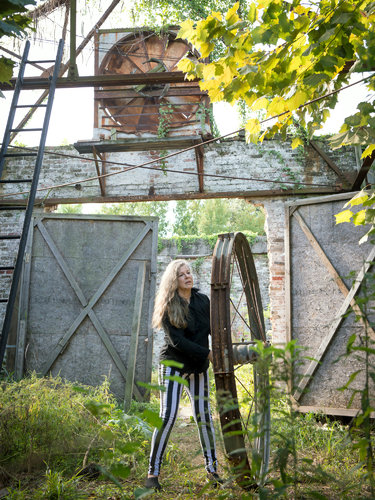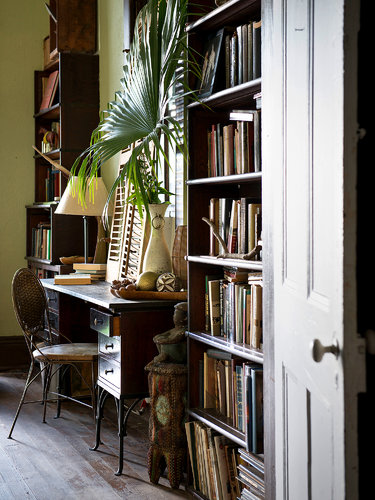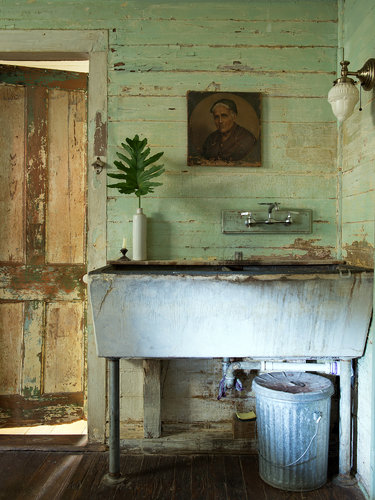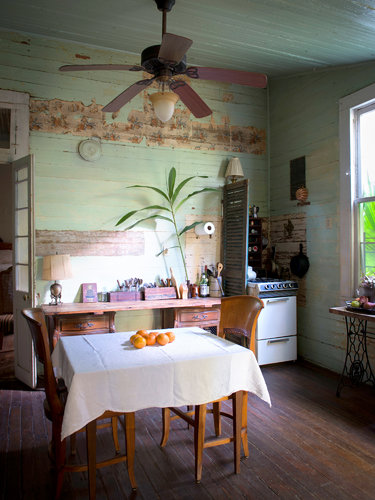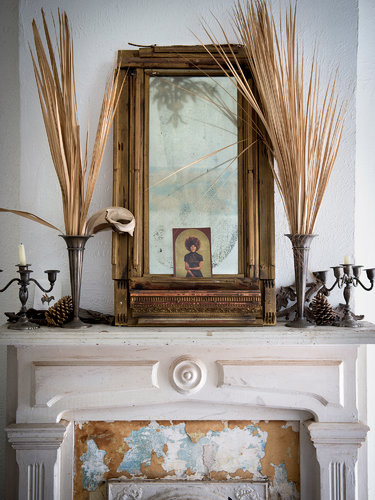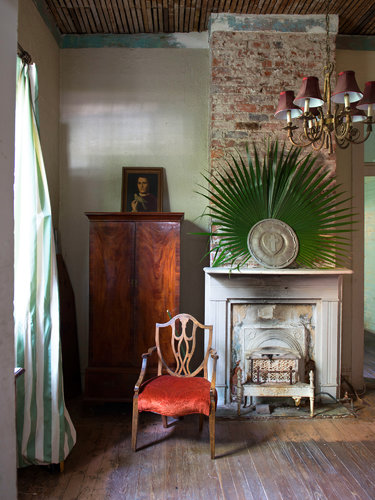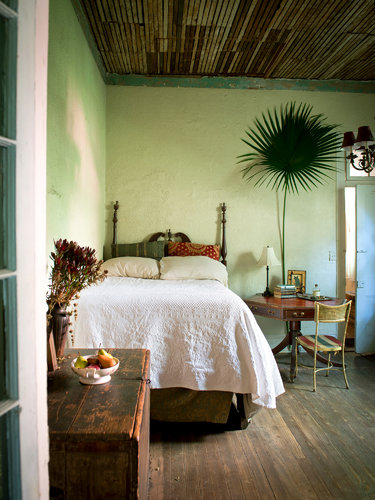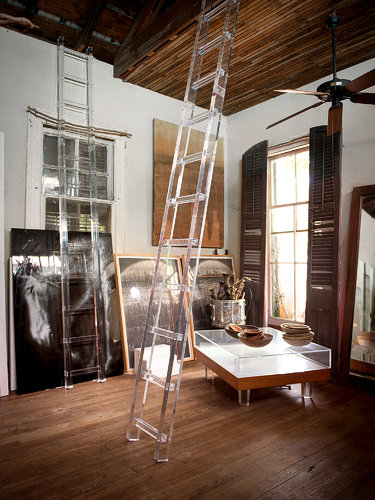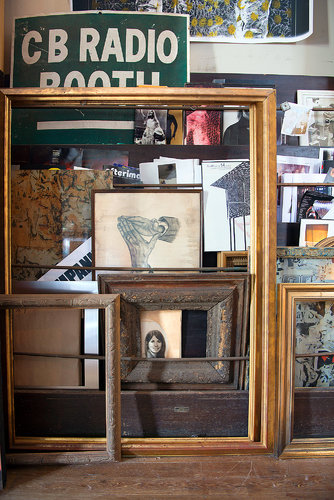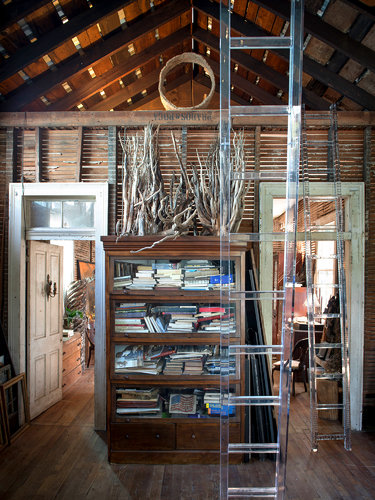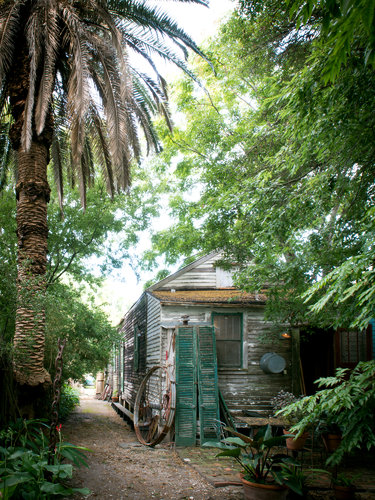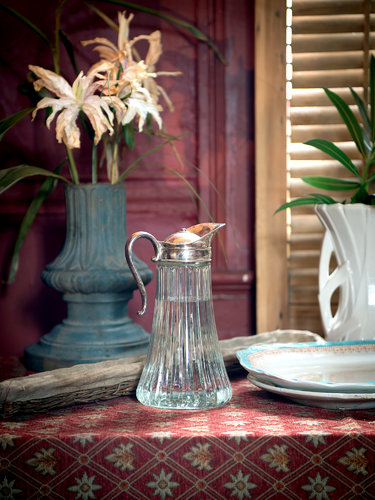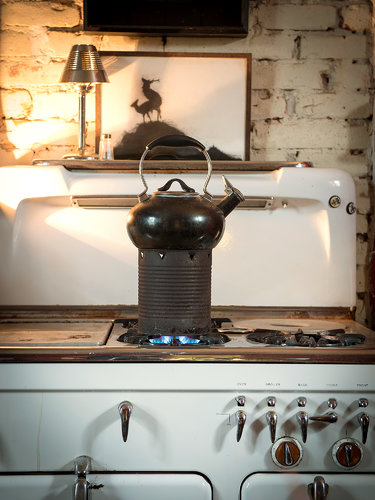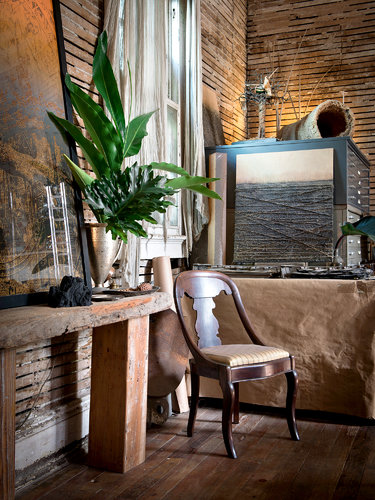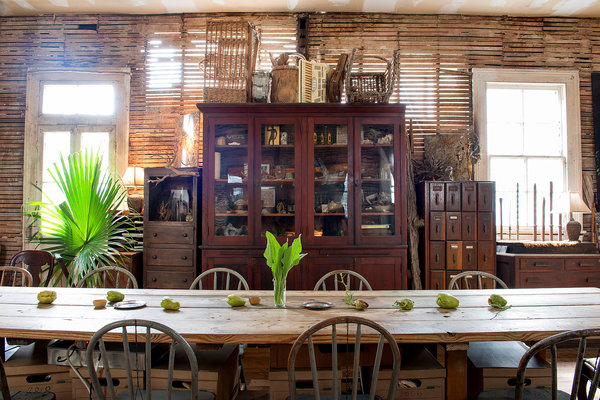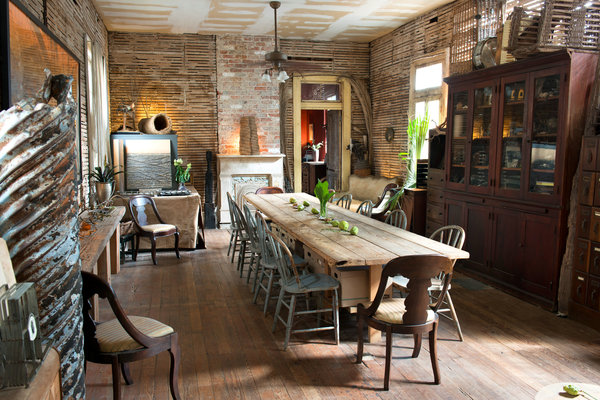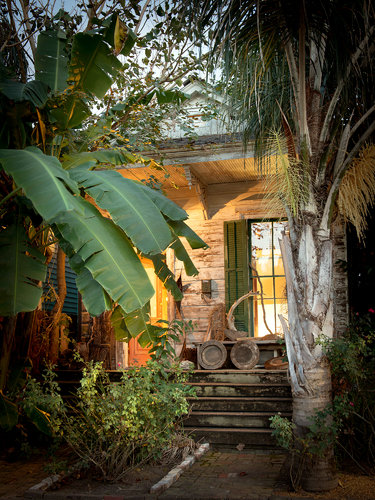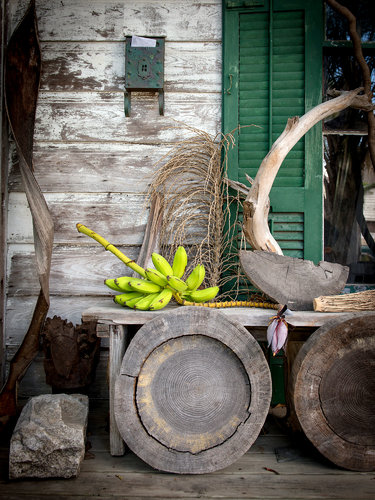by Penelope Green, via nytimes.com
October 15, 2014
Dawn DeDeaux has been thinking a lot about the apocalypse, and she’d like to get you in the mood, too.
“MotherShip,” her installation for Prospect.3, this town’s international biennial (which, in typical New Orleans fashion, has rolled around not quite on schedule), proposes an exit strategy from planet Earth. Ms. DeDeaux, a mixed-media artist, said she has taken to heart Stephen Hawking’s prediction that earthlings have 100 years left before the planet gives out. Opening Oct. 25, and set in an abandoned, roofless warehouse with trees growing through it, the installation will have recorded music by George Clinton and Sun Ra, giant steel rings that suggest those made for the zeppelins of yore, ladders and stacked chairs as a galactic assist, and places to store your mementos and Ms. DeDeaux’s. These last items will be souvenirs of Earth, answers to the question “If the world is ending, and you get to leave, what might you bring with you?”
As a daughter of New Orleans, Ms. DeDeaux, 63, has, of course, confronted the apocalypse before. Her Victorian gingerbread Art Shack, planted on the edge of the Fairgrounds Triangle neighborhood here, tells its post-Katrina tale in fragile and lovely ways. Its lath skeleton is plaster-free and looks like a ghostly X-ray of a house. There are burned timber fragments placed here and there, as elegant as Giacometti sculptures or African figures. A voluptuous metal culvert with a jagged, torn edge sits in front of a window. The plaster-daubed drywall ceiling lacks a finish coat of paint: after the hurricane blew the roof off, and Ms. DeDeaux received her FEMA money to replace it and the ceiling below, she stopped midway because she found the primed transitional ceiling appealing.
“Doesn’t it remind you of African mudcloth?” she asked a visitor.
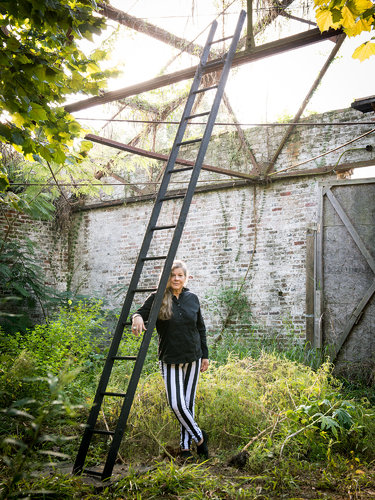
Paul Costello for The New York Times
Ms. DeDeaux, who wore a black shirt, black jeans and her curtain of hair draped over one shoulder, had just served this reporter a bang-up breakfast of sausages, bacon and eggs ordered from a diner nearby and presented on her 16-foot-long dining table. Since the hurricane, Ms. DeDeaux is big on takeout. “The storm changed my love for cooking,” she said, “because there were so many dead fridges.”
Before we hear her Katrina story, and the work that resulted from it, some background. Like most New Orleans histories, Ms. DeDeaux’s is appropriately gothic. From the age of 11, Ms. DeDeaux, the eldest of six children, was raised by her grandmother, Hilda Warfield, on Esplanade Avenue next door to the Degas House. This was after two of her siblings died within a year, she said, and her mother suffered extreme depression and left the family.
“I went a little mute,” Ms. DeDeaux said.
Her best friend was her grandmother’s gardener, Martin Green, then in his 40s, and the two of them learned to paint from a young artist from New York who was staying in the house. “Martin also became a serious artist, and he was really into outer space, which he would paint in Day-Glo colors,” Ms. DeDeaux said. “So this ‘MotherShip’ is dedicated to him in a way.”
The circular piece at the back of the Art Shack’s dining room is a digital image of a felled oak tree trunk that Ms. DeDeaux embedded in glass.
While she sneaked beers for Mr. Green and learned formal painting, her grandmother held court at the racetrack, where she went every day for lunch, cutting a figure in her hat and gloves. “She was like Auntie Mame,” Ms. DeDeaux said, recalling boisterous dinners on Esplanade with jockeys and other local characters.
At 15, Ms. DeDeaux considered herself an old master; by her early 20s, she was making installations out of telephone booths hooked up to CB radio channels. She was also part of the group that founded the Contemporary Arts Center here in 1976, she said, a year after she won the demolition derby in the Superdome.
As Ms. DeDeaux tells it, James Glassman, the owner of Figaro, an alternative newspaper that is now defunct, wanted to promote his publication at the derby. When his editors and reporters demurred, he persuaded Ms. DeDeaux, who was selling ads, to volunteer as a driver. “Deadly Dawn” was the moniker given to her by Jumpin’ Joe, the one-legged derby employee; she survived the experience by hugging the stadium walls while most of the participants smashed one another up, after which she backed up fast and took out the last couple of cars.
Ms. DeDeaux has gained notoriety for her work, too. A series of portraits of a street thug named Paul Hardy came out of arts programming she was doing in the local prison in the late 1980s. In 1994, one of the images, of a shirtless Mr. Hardy sporting a necklace with a revolver hanging from it, made its way into the Whitney Museum as part of the infamous “Black Male” show curated by Thelma Golden, which drew criticism for promoting, rather than upending, cultural stereotypes. The fallout for Ms. DeDeaux was an F.B.I. raid on her studio during the trial of Len Davis, a member of the New Orleans Police Department convicted of hiring Mr. Hardy to kill a young mother of three who had charged Mr. Davis with brutality. (Mr. Hardy is serving a life term in prison, and Mr. Davis is on death row.)
In 1997, Ms. DeDeaux was lucky enough to spend eight months in Rome, part of which was a three-month fellowship at the American Academy there. When she returned, she was determined, she said, to own a piece of her hometown. She bought two tiny shotgun houses a block or so away from each other, one for about $35,000 and another, what would become the Art Shack, for about $38,000, both of which were owner-financed. “I had no credit rating, but with the sale of a piece I had some cash,” she said.
The first house was for sleeping, and the second was for her digital work. “This was the clean place, for all my computers,” she said, gesturing around the Art Shack. She also bought a studio nearby, a 7,000-square-foot former horse barn, in which she stored her artwork and materials: architectural salvage, bits of furniture, sheets of metal, old light fixtures and antique timbers.
Ms. DeDeaux left town the Sunday before Katrina hit, with a massive hangover (she had had a dinner party the night before), in a van loaded with her computers, three neighbors who were afraid to go to the Superdome, an out-of-towner who had been staying with her and working on her website, six finches, an aged dog and a cat.
When she returned a month later to “the stew,” after a harrowing getaway and exile, the roofs of both houses had been staved in by fallen trees and the back half of the studio had collapsed, destroying a third of her work. “Thank God I’m no longer a painter,” she said. “I’m just a smoke-and-mirrors conceptual artist.”
When she first bought the Art Shack, she had stripped the plaster from one wall and exposed the lath to let light into the main room. After Katrina, all the plaster had to go, along with a sizable amount of exterior cladding. Unfazed, Ms. DeDeaux pulled off a few more clapboards and bolstered the exterior with sheets of safety glass, happily noting how much brighter the place was.
Lately, she has been irritated by the fresh coat of bright blue paint on the house next door that glows through her porous walls. Tacked onto her window are various drawing papers in creams and browns, not quite satisfactory scrims to tone down the bright color leaking through. “I’m a monochromist,” she said. “I’ve got to figure this out.”
Perhaps a bigger blow came a year after Katrina, when her studio burned to the ground, destroying much of her work, her materials and treasures like paintings made by Mr. Green. It was accidental, she said, a fire made by exiles bused in to vote on a freezing cold night, who had no place to stay. When the fire department arrived, there was no water pressure.
“I was so disheartened,” she said, “because I can fully accept the outcomes of nature, but I had the hardest damn time accepting the folly of man, of politics.”
But like many local artists, she started making work out of the debris and, later, about the disasters, plural. (Five years after Katrina, you’ll recall, New Orleans entertained the Deepwater Horizon oil spill.) She used Elmer’s glue, mud and string on plywood to make poetic dirt abstracts. She embedded acrylic slabs with digital images of water. She salvaged 12 burned timbers from the barn and put them in a show. She harvested storm culverts from a debris pile, bracketed them to a gallery’s walls and embedded them with speakers that played an old Delta blues song, “Lord Help the Poor and Needy.”
Charred relics from the fire can be spotted throughout the Art Shack: those elegant black timbers; a limited-edition book made for the Percent for Art program that sponsored her prison programming, its crumbly singed pages bracketed in a metal grid made to look like prison bars; a metal case of singed postcards of European artworks that Ms. DeDeaux will set out in the “MotherShip” installation, as part of the souvenir section.
“Say we do have to leave,” Ms. DeDeaux said. “We can’t fit the Mona Lisas or the Davids on the ship, so these little postcards are stand-ins.”
She added sternly: “This is not just another generation’s apocalypse. We have some math here.”
Then she broke off. “It’s funny talking about this in the shack,” she said.
Ms. DeDeaux is still using her other house down the block, a.k.a. the Oyster Shack, as her bedroom, though the other day she had guests and was camped out in the Art Shack. She demonstrated how she sleeps there, laid out like a corpse in a coffin on a diminutive antique sofa, arms folded on her chest and her ankles neatly crossed. “I don’t move in the night,” she explained.
Ms. DeDeaux has a flair, said D. Eric Bookhardt, a New Orleans art critic, “a genetic French flair, for drama and a certain kind of flourish.” He likened the Art Shack to a “manic Louise Nevelson, with a texture like something a Creole Anselm Kiefer might have concocted. As a sculpture posing as a house, it’s pretty interesting.”
This will be Ms. DeDeaux’s second Prospect (the show has been held three and a half times, but that’s another story). Dan Cameron, the former New Museum curator who created Prospect.1 in 2008, invited Ms. DeDeaux to participate in P.2, as it was abbreviated, held in 2011. Her installation was inspired by John Kennedy Toole’s “Confederacy of Dunces” and involved many participants and co-conspirators. Held in the courtyard of the Brulatour House, an early-19th-century landmark here, there were drag queen Bounce dancers — think twerking, and then some (Bounce is a New Orleans version of hip-hop, and so-called Sissy Bounce is a wildly popular splinter movement) — 77 mannequins in dunce caps and an iron bed fitted with carnival-float wheels set over a fountain that erupted from its midsection.
“It really was the talk of the town for some time,” said Mr. Cameron, who is now chief curator of the Orange County Museum of Art in Newport Beach, Calif. “Whatever you’re up for, Dawn will meet you halfway, and before you know it, the two of you are up and running to take over the world together. She’s a restless spirit, so if you drop her down somewhere like a shotgun house, she’s going to transform it. She doesn’t accept the given structure of most anything.”
He added: “That house has become a piece about fragility and the tenuous hold we have on this earth.”
Which brings us back to the apocalypse. Last summer, pieces of the “MotherShip” extravaganza were on view at the Acadiana Center for the Arts, in Lafayette, La. When Ms. DeDeaux asked Mary Beyt, the curator there, what souvenir Ms. Beyt might bring on a galactic ark, she answered promptly. “Definitely Tylenol,” Ms. Beyt said.
[All images by Paul Costello for The New York Times]
